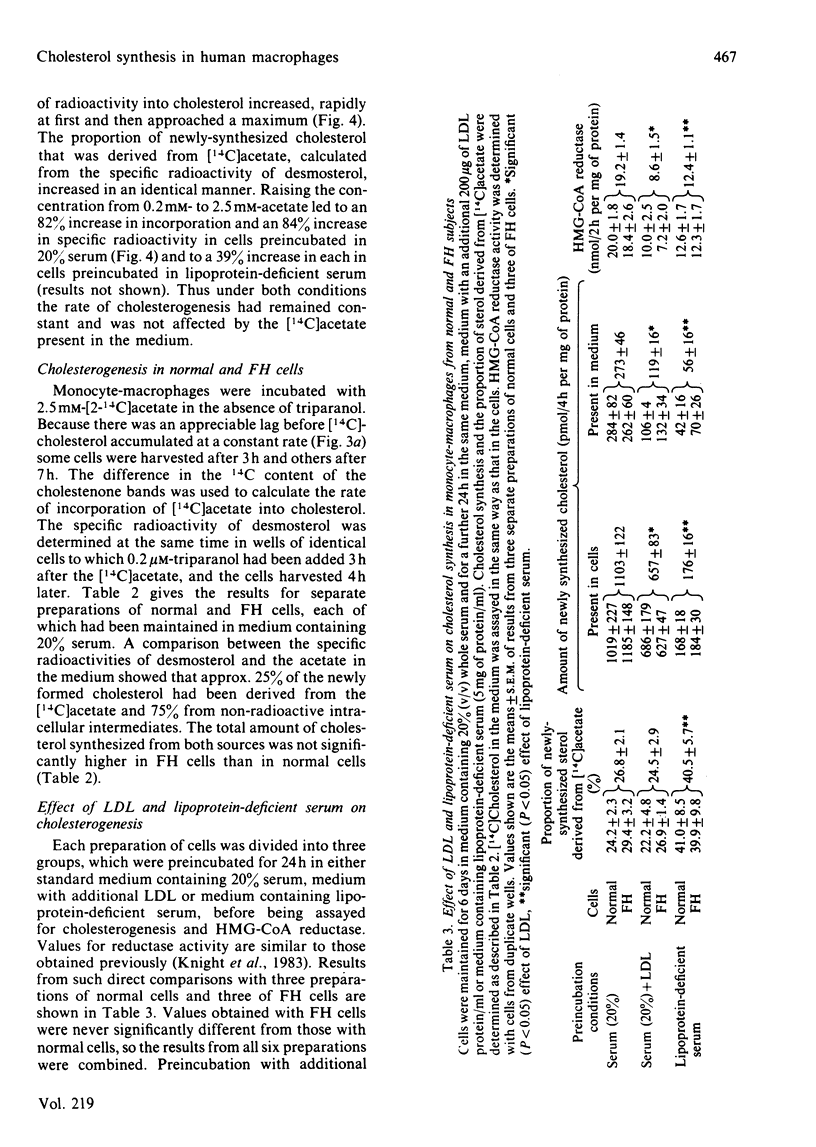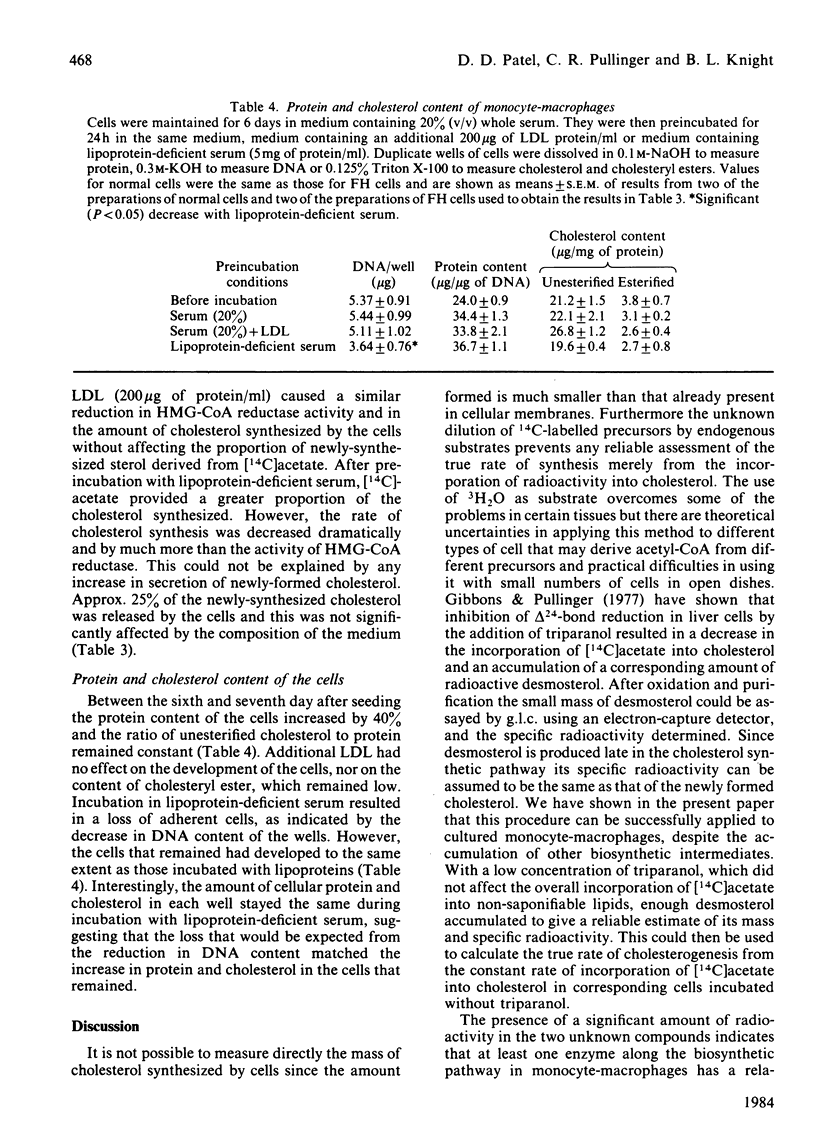Abstract
The true rate of cholesterogenesis in cultured monocyte-macrophages was determined from the incorporation of [2-14C]acetate into cholesterol, using the desmosterol (cholesta-5,24-dien-3 beta-ol) that accumulated in the presence of the drug triparanol to estimate the specific radioactivity of the newly formed sterols. It was shown that this procedure could be successfully adapted for use with cultured monocytes despite the accumulation of other unidentified biosynthetic intermediates. In cells maintained in 20% (v/v) whole serum approx. 25% of the sterol carbon was derived from exogenous acetate. Cholesterol synthesis was as high in normal cells as in cells from homozygous familial hypercholesterolaemic (FH) subjects and accounted for 50% of the increase in cellular cholesterol. The addition of extra low-density lipoprotein (LDL) reduced cholesterol synthesis, apparently through a decrease in the activity of 3-hydroxy-3-methylglutaryl-CoA reductase (HMG-CoA reductase). When incubated in lipoprotein-deficient serum some cells did not survive, but those that remained showed a normal increase in protein content; the amount of cellular protein and cholesterol in each well did not increase and cholesterol synthesis was reduced by over 80%. HMG-CoA reductase activity fell less dramatically and the proportion of sterol carbon derived from exogenous acetate increased, suggesting that the low rate of cholesterogenesis with lipoprotein-deficient serum was due to a shortage of substrate. The results indicate that under normal conditions monocyte-macrophages obtain cholesterol from endogenous synthesis rather than through receptor-mediated uptake of LDL, and that synthesis together with non-saturable uptake of LDL provides the majority of the cholesterol required to support growth.
Full text
PDF









Images in this article
Selected References
These references are in PubMed. This may not be the complete list of references from this article.
- Bensadoun A., Weinstein D. Assay of proteins in the presence of interfering materials. Anal Biochem. 1976 Jan;70(1):241–250. doi: 10.1016/s0003-2697(76)80064-4. [DOI] [PubMed] [Google Scholar]
- Donkersloot J. A., Robrish S. A., Krichevsky M. I. Fluorometric determination of deoxyribonucleic acid in bacteria with ethidium bromide. Appl Microbiol. 1972 Aug;24(2):179–183. doi: 10.1128/am.24.2.179-183.1972. [DOI] [PMC free article] [PubMed] [Google Scholar]
- FOLCH J., LEES M., SLOANE STANLEY G. H. A simple method for the isolation and purification of total lipides from animal tissues. J Biol Chem. 1957 May;226(1):497–509. [PubMed] [Google Scholar]
- Fogelman A. M., Hokom M. M., Haberland M. E., Tanaka R. D., Edwards P. A. Lipoprotein regulation of cholesterol metabolism in macrophages derived from human monocytes. J Biol Chem. 1982 Dec 10;257(23):14081–14086. [PubMed] [Google Scholar]
- Gibbons G. F., Pullinger C. R. Measurement of the absolute rates of cholesterol biosynthesis in isolated rat liver cells. Biochem J. 1977 Feb 15;162(2):321–330. doi: 10.1042/bj1620321. [DOI] [PMC free article] [PubMed] [Google Scholar]
- Gibbons G. F., Pullinger C. R. Utilization of endogenous and exogenous sources of substrate for cholesterol biosynthesis by isolated hepatocytes. Biochem J. 1979 Jan 1;177(1):255–263. doi: 10.1042/bj1770255. [DOI] [PMC free article] [PubMed] [Google Scholar]
- Goldstein J. L., Brown M. S. The low-density lipoprotein pathway and its relation to atherosclerosis. Annu Rev Biochem. 1977;46:897–930. doi: 10.1146/annurev.bi.46.070177.004341. [DOI] [PubMed] [Google Scholar]
- Johnson W. D., Jr, Mei B., Cohn Z. A. The separation, long-term cultivation, and maturation of the human monocyte. J Exp Med. 1977 Dec 1;146(6):1613–1626. doi: 10.1084/jem.146.6.1613. [DOI] [PMC free article] [PubMed] [Google Scholar]
- Knight B. L., Patel D. D., Soutar A. K. The regulation of 3-hydroxy-3-methylglutaryl-CoA reductase activity, cholesterol esterification and the expression of low-density lipoprotein receptors in cultured monocyte-derived macrophages. Biochem J. 1983 Feb 15;210(2):523–532. doi: 10.1042/bj2100523. [DOI] [PMC free article] [PubMed] [Google Scholar]
- Knight B. L., Soutar A. K. Changes in the metabolism of modified and unmodified low-density lipoproteins during the maturation of cultured blood monocyte-macrophages from normal and homozygous familial hypercholesterolaemic subjects. Eur J Biochem. 1982 Jul;125(2):407–413. doi: 10.1111/j.1432-1033.1982.tb06698.x. [DOI] [PubMed] [Google Scholar]
- Knight B. L., Soutar A. K. Degradation by cultured fibroblasts and macrophages of unmodified and 1,2-cyclohexanedione-modified low-density lipoprotein from normal and homozygous familial hypercholesterolaemic subjects. Biochem J. 1982 Jan 15;202(1):145–152. doi: 10.1042/bj2020145. [DOI] [PMC free article] [PubMed] [Google Scholar]
- LOWRY O. H., ROSEBROUGH N. J., FARR A. L., RANDALL R. J. Protein measurement with the Folin phenol reagent. J Biol Chem. 1951 Nov;193(1):265–275. [PubMed] [Google Scholar]
- Musson R. A., Shafran H., Henson P. M. Intracellular levels and stimulated release of lysosomal enzymes from human peripheral blood monocytes and monocyte-derived macrophages. J Reticuloendothel Soc. 1980 Sep;28(3):249–264. [PubMed] [Google Scholar]
- Pullinger C. R., Gibbons G. F. The relationship between the rate of hepatic sterol synthesis and the incorporation of [3H]water. J Lipid Res. 1983 Oct;24(10):1321–1328. [PubMed] [Google Scholar]
- Soutar A. K., Knight B. L. Degradation by cultured monocyte-derived macrophages from normal and familial hypercholesterolaemic subjects of modified and unmodified low-density lipoproteins. Biochem J. 1982 May 15;204(2):549–556. doi: 10.1042/bj2040549. [DOI] [PMC free article] [PubMed] [Google Scholar]



